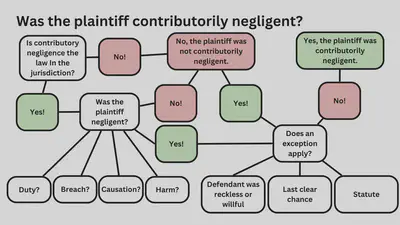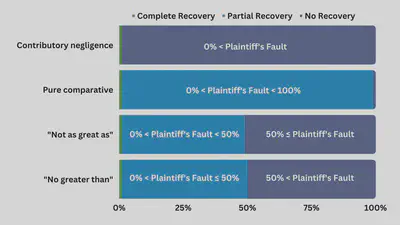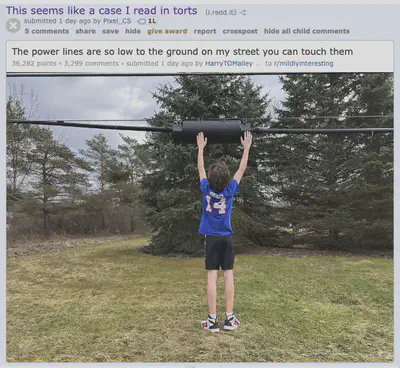Negligence Defenses Review
Today’s Agenda
- Review of Defenses
- In-Class Exercise
Negligence
Elements of a cause of action:
— Duty
— Breach
— Causation
— Harm
Defenses:
— Contributory or Comparative Negligence
— Assumption of Risk
The kinds of questions you can now answer:
- Does the defense of contributory negligence apply? - Was the plaintiff comparatively negligent? - Does the defense of “assumption of risk” apply?
Given information about jurisdictional rules and case-specific information about each party’s comparative fault:
- How much can the plaintiff recover?
- How much does each defendant owe?
- If a particular defendant is absent or insolvent, how much do the other defendants owe?
Contributory Negligence in General:
The defendant is not liable
If the plaintiff was also negligent
— Duty,
— Breach,
— Causation, and
— Harm
Unless an exception applies:
— Last clear chance,
— Recklessness or willfulness of defendant, or
— Statute

Comparative Negligence
Three forms:
- Pure comparative negligence
- “Not as great as” = (Plaintiff less than 50% at fault)
- “No greater than” = (Plaintiff 50% or less at fault)
Can the negligent plaintiff recover damages?

How much does each defendant pay?
Common Law Approach
Divide up damages by number of liable defendants
Doctrine of contribution:
- Joint and several liability, or
- Several liability
How much does each defendant pay?
Modern Approach
Divide up damages based on comparative fault
Doctrine of contribution:
Variety of rules across jurisdictions, including several liability, joint-and-several liability, and a variety of hybrids.
Don’t
forget about
factual cause!
Order of operations for allocating damages with multiple injuries and multiple defendants
First step: Separate injuries based on factual cause.
Second step: For injuries that multiple defendants caused, sort out who owes what based on jurisdictional rules.
Assumption of Risk
Assumption of Risk
- Explicit / Express
- Implicit
-— Primary
-— Secondary
Two Common Issues with Explicit Assumption of Risk
- Was the contract clear enough about releasing the defendant from liability?
- Will the court enforce contract?
Will the court enforce contract?
Various legal tests for determining if liability waiver is against public policy:
- Liability waivers are unenforceable
- Totality of the circumstances
- Six factors from Tunkl
Implicit assumption of risk
volenti non fit injuria
“to one who is willing, no wrong is done”
Should assumption of risk persist in a comparative fault world?
- Explicit / Express → Duty
- Implicit
-— Primary → Duty
-— Secondary → Comparative Fault
For exam questions, how do we know whether to look to assumption of risk or contributory negligence or comparative negligence?

In the Vargas family’s home, a power strip manufactured by the Unreliable Breaker Company failed to go off during a temporary short circuit, starting a fire. The only person at home at the time was a napping one-year-old, Emily Vargas. Her babysitter had briefly left the home to take the family dog for a walk. Emily’s fifteen-year-old sister, Lynn Vargas, returned home from school to find a fire consuming the home. Seeing that Jennifer was down the street with the dog, Lynn raced inside, grabbed Emily and managed to get her out safely, but Lynn was burned in the process. Lynn and Emily’s father, Tito Vargas, then arrived home, saw that his daughters were safe, and ran into the house to try to save his pet parrot. He succeeded but also suffered burns in the process. Moments later Tatiana Vargas, Tito’s spouse, arrived home. Tatiana is your typical absentminded law professor. Deep in thought about the viability of assumption of risk as an absolute defense in a comparative negligence world, she didn’t notice the fire, walked in the front door, and was burned. At this point, the firefighters arrived on scene. A firefighter, Pat Murphy, ran into the house and rescued Tatiana, but he was also burned.
If Lynn, Tito, Tatiana, and Pat each sue the Unreliable Breaker Company for negligence, would there be any affirmative defenses that the company could assert? What would be the differences in the analysis of the applicability of those defenses to each plaintiff?
Version #1
You are an associate working at a firm that represents the Unreliable Breaker Company.
The state of Loyola (where this case takes place) takes a common law approach to tort defenses. Unlike most jurisdictions in the United States, Loyola is still a contributory negligence regime with joint-and-several liability. Assumption of risk is a complete defense.
Lynn, Tito, Tatiana, and Pat are each suing the Unreliable Breaker Company for negligence. A senior associate has asked you to write an email detailing any affirmative defenses that the company could assert against each plaintiff’s claim. The senior associate has specifically asked you to only address affirmative defenses at this time, so there’s no need to address whether the plaintiffs can prove the elements of duty, breach, causation, and a harm.
Version #2
You are an associate working at a plaintiff-side firm.
The state of Loyola (where this case takes place) takes a modern approach to tort defenses. Loyola is a “not as great as” comparative negligence regime with several liability. Assumption of risk is a complete defense for explicit and primary assumption of risk but not for secondary assumption of risk, where comparative fault suffices.
Your firm is considering representing Lynn, Tito, Tatiana, and Pat, who each want to sue the Unreliable Breaker Company for negligence. As the firm works on a contingency fee basis, we want to take on cases that are the easiest to win and we don’t want to take on cases that would cost the firm money. A senior associate has asked you to write an email detailing any affirmative defenses that the company could assert against each plaintiff’s claim. In your analysis, please describe which cases you think our firm should prioritize and which plaintiffs, if any, our firm should decline to represent based upon possible affirmative defenses. The senior associate has specifically asked you to only address affirmative defenses at this time, so there’s no need to address whether the plaintiffs can prove the elements of duty, breach, causation, and a harm.